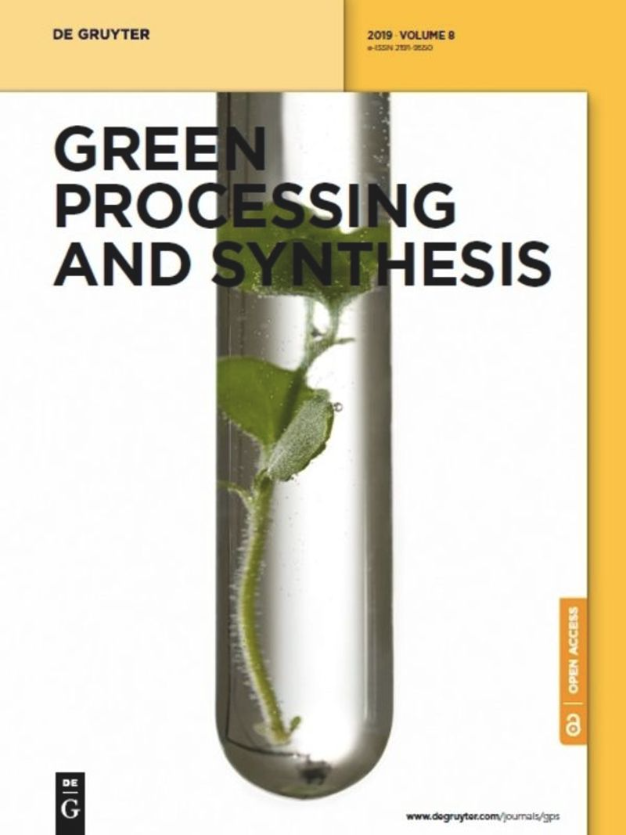Biodegradation of synthetic PVP biofilms using natural materials and nanoparticles
IF 3
4区 工程技术
Q2 CHEMISTRY, MULTIDISCIPLINARY
引用次数: 2
Abstract
Abstract Biodegradable nanofilms from polyvinyl pyrrolidone (PVP), carboxymethyl cellulose (CMC), citric acid (CA), glycerol (G), and zinc oxide nanoparticles (ZnO-NPs) were prepared using different ZnO concentrations and different electron beam irradiation doses, enabling crosslinking formation. The prepared films were characterized by X-ray diffractometer, Fourier transform infrared spectroscopy, thermogravimetric analyser, and transmission electron microscopy. The swelling percentage of PVP:CMC films was ordered in the sequence of composition ratio 1:2 > 1:1 > 2:1. Results showed decrease in swelling capacity accompanied by increase in gelation percentage of (PVP:CMC)/CA/G)/ZnO nanofilms as the irradiation dose increased up to 20 kGy. The tensile strength of (PVP:CMC) films increased by the incorporation of ZnO-NPs and increasing the irradiation dose. The thermal stability of the prepared (PVP:CMC)/CA/G/ZnO nanofilms was enhanced as the irradiation dosage increased. The water vapour transmission rate of the irradiated films was decreased. The biodegradability of the prepared nanofilms was monitored during 16 weeks and it exceeded 65% weight loss from the original blank weight. Moreover, the nanofilms exhibit antimicrobial activity against fungi, Gram-negative, and Gram-positive bacteria. The broad antimicrobial activity spectrum of the prepared nanofilms increased as the concentration of ZnO-NPs increased. These results suggested that (PVP:CMC)/CA/G/ZnO nanofilms can serve as biodegradable materials in various applications characterized by antimicrobial activity.天然材料和纳米颗粒对合成PVP生物膜的生物降解
摘要以聚乙烯吡咯烷酮(PVP)、羧甲基纤维素(CMC)、柠檬酸(CA)、甘油(G)和氧化锌纳米颗粒(ZnO NP)为原料,采用不同的ZnO浓度和不同的电子束辐照剂量制备了可生物降解的纳米膜,使交联形成。用X射线衍射仪、傅立叶变换红外光谱、热重分析仪和透射电子显微镜对制备的薄膜进行了表征。PVP:CMC薄膜的溶胀率按组成比1:2>1:1>2:1的顺序排列。结果表明,当辐照剂量增加到20时,(PVP:CMC)/CA/G)/ZnO纳米膜的溶胀能力降低,同时凝胶化百分比增加 kGy。(PVP:CMC)薄膜的拉伸强度随着ZnO NPs的加入和辐照剂量的增加而增加。所制备的(PVP:CMC)/CA/G/ZnO纳米薄膜的热稳定性随着辐照剂量的增加而增强。辐照后薄膜的水蒸气透过率降低。在16周期间监测所制备的纳米膜的生物降解性,并且其从原始空白重量的重量损失超过65%。此外,纳米膜对真菌、革兰氏阴性菌和革兰氏阳性菌表现出抗菌活性。所制备的纳米膜的广谱抗菌活性谱随着ZnO纳米粒子浓度的增加而增加。这些结果表明,(PVP:CMC)/CA/G/ZnO纳米膜可以作为生物可降解材料应用于各种具有抗菌活性的应用中。
本文章由计算机程序翻译,如有差异,请以英文原文为准。
求助全文
约1分钟内获得全文
求助全文
来源期刊

Green Processing and Synthesis
CHEMISTRY, MULTIDISCIPLINARY-ENGINEERING, CHEMICAL
CiteScore
6.70
自引率
9.30%
发文量
78
审稿时长
7 weeks
期刊介绍:
Green Processing and Synthesis is a bimonthly, peer-reviewed journal that provides up-to-date research both on fundamental as well as applied aspects of innovative green process development and chemical synthesis, giving an appropriate share to industrial views. The contributions are cutting edge, high-impact, authoritative, and provide both pros and cons of potential technologies. Green Processing and Synthesis provides a platform for scientists and engineers, especially chemists and chemical engineers, but is also open for interdisciplinary research from other areas such as physics, materials science, or catalysis.
 求助内容:
求助内容: 应助结果提醒方式:
应助结果提醒方式:


